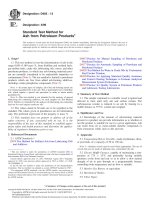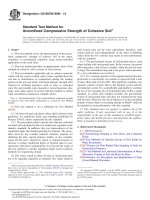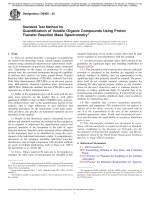ASTM D61 − 15 (Reapproved 2019) Standard Test Method for Softening Point of Pitches (CubeinWater Method)
Bạn đang xem bản rút gọn của tài liệu. Xem và tải ngay bản đầy đủ của tài liệu tại đây (104.23 KB, 4 trang )
This international standard was developed in accordance with internationally recognized principles on standardization established in the Decision on Principles for the
Development of International Standards, Guides and Recommendations issued by the World Trade Organization Technical Barriers to Trade (TBT) Committee.
Designation: D61 − 15 (Reapproved 2019)
Standard Test Method for
Softening Point of Pitches (Cube-in-Water Method)1
This standard is issued under the fixed designation D61; the number immediately following the designation indicates the year of original
adoption or, in the case of revision, the year of last revision. A number in parentheses indicates the year of last reapproval. A superscript
epsilon (´) indicates an editorial change since the last revision or reapproval.
1. Scope E2251 Specification for Liquid-in-Glass ASTM Thermom-
eters with Low-Hazard Precision Liquids
1.1 This test method covers the determination of the soft-
ening point of pitches below 176 °F (80 °C). Pitches of higher E2877 Guide for Digital Contact Thermometers
softening point should be tested by Test Method D2319 or Test
Method D3104. 3. Terminology
1.2 The values stated in inch-pound units are to be regarded 3.1 Definitions:
as standard. The values given in parentheses are mathematical 3.1.1 Digital Contact Thermometer (DCT), n—an electronic
conversions to SI units that are provided for information only device consisting of a digital display and associated tempera-
and are not considered standard. ture sensing probe.
3.1.1.1 Discussion—This device consists of a temperature
1.3 This standard does not purport to address all of the sensor connected to a measuring instrument; this instrument
safety concerns, if any, associated with its use. It is the measures the temperature-dependent quantity of the sensor,
responsibility of the user of this standard to establish appro- computes the temperature from the measured quantity, and
priate safety, health, and environmental practices and deter- provides a digital output or display, or both, of the temperature.
mine the applicability of regulatory limitations prior to use. The temperature sensing probe is in contact with the material
whose temperature is being measured. This device is some-
1.4 This international standard was developed in accor- times referred to as a digital thermometer.
dance with internationally recognized principles on standard-
ization established in the Decision on Principles for the NOTE 1—Portable electronic thermometers (PET) is an acronym some-
Development of International Standards, Guides and Recom- times used to refer to a subset of the devices covered by this definition.
mendations issued by the World Trade Organization Technical
Barriers to Trade (TBT) Committee. 4. Summary of Test Method
2. Referenced Documents 4.1 Two cubes of pitch, supported on wire hooks, are heated
at a controlled rate in water in a glass container. The softening
2.1 ASTM Standards:2 point is defined as the mean of the temperatures at which the
D140 Practice for Sampling Asphalt Materials cubes sag downwards a distance of 25 mm.
D2319 Test Method for Softening Point of Pitch (Cube-in-
5. Significance and Use
Air Method)
D3104 Test Method for Softening Point of Pitches (Mettler 5.1 Pitch does not go through a solid-liquid phase change
when heated, and therefore it does not have a true melting
Softening Point Method) point. As the temperature rises, pitch softens and becomes less
E1 Specification for ASTM Liquid-in-Glass Thermometers viscous. The softening point is arbitrarily defined and shall be
E563 Practice for Preparation and Use of an Ice-Point Bath established by a closely controlled method which shall be
carefully followed if test results are to be reproducible.
as a Reference Temperature
E1137 Specification for Industrial Platinum Resistance Ther- 5.2 This test is useful in determining the consistency of
pitch as one element in establishing the uniformity of ship-
mometers ments or sources of supply.
1 This test method is under the jurisdiction of ASTM Committee D02 on 6. Apparatus
Petroleum Products, Liquid Fuels, and Lubricantsand is the direct responsibility of
Subcommittee D02.05 on Properties of Fuels, Petroleum Coke and Carbon Material. 6.1 Mold—A mold suitable for forming two 1⁄2 in.
(12.7 mm) cubes of pitch, having cylindrical core pins 12
Current edition approved Dec. 1, 2019. Published December 2019. Originally gauge (2.05 mm) in diameter located in the base plate of the
approved in 1919. Last previous edition approved in 2015 as D61 – 15. DOI: assembly to produce accurately centered suspension holes in
10.1520/D0061-15R19. the cubes. (See Fig. 1.)
2 For referenced ASTM standards, visit the ASTM website, www.astm.org, or
contact ASTM Customer Service at For Annual Book of ASTM
Standards volume information, refer to the standard’s Document Summary page on
the ASTM website.
Copyright © ASTM International, 100 Barr Harbor Drive, PO Box C700, West Conshohocken, PA 19428-2959. United States
1
D61 − 15 (2019)
FIG. 1 Apparatus for Cube-in-Water Method
6.2 Hooks—Two L-shaped hooks, made of 12 gauge glass thermometers described in 6.4.2. A DCT or calibrated
(2.05 mm) copper wire. The foot of the hook shall be 1 in. liquid-in-glass thermometer shall be used as the thermometer
(25 mm) long and at a right angle to the upright portion for for temperature measurement independent of the instrument’s
insertion into the center hole of the pitch cube. temperature control, and shall be located in the thermowell.
6.3 Container—A glass vessel that can be heated, not less NOTE 2—The display device and sensor must be correctly paired.
than 85 mm in diameter and 105 mm deep. (A standard 600 mL Incorrect pairing will result in temperature measurement errors and
low-form beaker meets these requirements). possibly irreversible damage to the electronics of the display.
6.4 Temperature Measuring Device—Use either a calibrated
DCT meeting the requirements described in 6.4.1 or liquid-in-
2
D61 − 15 (2019)
6.4.1 Digital Contact Thermometer Requirements: ice point by one scale division, or until five years has elapsed
since the last full calibration.
Criteria Requirements
E2877 Class E, Minimum 6.5 Heat Source:
DCT 6.5.1 Electric Heater—A hot plate or immersion heater
provided with a variable transformer or other device suitable
Temperature range –2 °C to 80 °C for regulating the temperature of the heating element.
6.5.2 Gas Heater—A bunsen-type burner, fitted with a
Display resolution 0.1 °C chimney.
Sensor type PRT, thermistor, Type E or T thermocouple 7. Sampling
Sensor, sheath Metal or glass 7.1 Samples from shipments shall be taken in accordance
with Practice D140 and shall be free of foreign substances.
Sensor length Less than 12 mm in length Thoroughly mix the sample before removing a representative
portion for the determination or for dehydration.
Immersion depth 76 mm
7.2 If the presence of water is indicated by surface foam on
Display accuracy ±0.2 °C for combined probe and sensor heating, maintain the sample at a temperature of about 260 °F
(125 °C) in an open container until the surface is free of foam.
Response time Less than or equal to 30 s as defined in Specifica- Take care not to overheat, and remove from the heat source as
tion E1137 soon as the foam has subsided.
Drift Less than 0.2 °C per year 8. Test Specimens
Calibration error Less than 0.2 °C over the range of intended use 8.1 Coat the inner surfaces and core pins of the mold very
lightly with silicone oil or silicone grease. Form the pitch into
Calibration range –2 °C to 80 °C truly shaped cubes either by pressing (8.2) or by pouring (8.4),
the latter being preceded by melting (8.3) if the sample is solid.
Calibration data 4 data points evenly distributed over the range Use an excess of pitch in either case. Cool until firm and
and included in calibration report remove the surplus material by drawing the heated blade of a
putty knife or spatula across the surface of the mold so that the
Calibration report From a calibration laboratory with demonstrated cubes are pressed into the cavities. Then open the mold and
competency in temperature calibration which is remove the cubes carefully to avoid distortion. Inspect each
traceable to a national calibration laboratory or specimen for possible cracks or bubbles and reject any which
metrology standards body are not perfect.
6.4.1.1 The DCT calibration drift shall be checked at least 8.2 Pitches with softening points up to about 140 °F (60 °C)
annually by either measuring the ice point or against a can usually be pressed into the mold by hand at, or slightly
reference thermometer in a constant temperature bath at the above, room temperature. If too soft, they may be pressed
prescribed immersion depth to ensure compliance with 6.4.1. under water at about 40 °F (5 °C).
With respect to an ice bath, Practice E563 provides guidance
on the preparation and use of an ice bath. However, for this use, 8.3 To melt a dry pitch sample, add the material to a
variance from the specific steps, such as water source, is container having a height equal to or exceeding its width and
permitted provided preparation is consistent. The basis for the a volume of not less than 50 mL, until it is about half full. Place
variance is due to the ice bath reference being used for tracking the container on a hot plate, or in an oven or bath. Do not use
change in calibration not verification. an open flame for melting pitch. After melting is complete, stir
gently but thoroughly, avoiding the incorporation of air
NOTE 3—When a DCT’s calibration drifts in one direction over several bubbles. The maximum temperature should not exceed the
calibration checks, that is, ice point, it may be an indication of deteriora- expected softening point by more than 90 °F (50 °C). Any
tion of the DCT. foam that forms shall be skimmed off.
6.4.2 An ASTM Low Softening Point Thermometer having 8.4 Pour a slight excess of the liquid pitch into the mold
a range from –2 °C to 80 °C and conforming to the require- with the lip of the container close to the surface so as to
ments for Thermometer 15 as described in Specification E1 or minimize the entrainment of air bubbles. Underpouring past
E2251. the blade of a spatula is helpful in this respect. Even small
bubbles markedly affect the weight of the cube and the
6.4.2.1 Calibration Check—Verify thermometer at least an- observed softening point. Cool the specimens in the mold until
nually against a reference thermometer in a constant tempera- firm, under cold water if necessary; then trim and inspect the
ture bath or an ice bath. The thermometer is to be inserted to its cubes as directed in 8.1.
immersion depth. If using an ice bath, the ice point reading is
to be taken within 60 min after the thermometer has been at test 9. Procedure
temperature for at least 3 min. If the corrected temperature
reading deviates from the reference thermometer or the ice 9.1 Pitches Having Softening Points Between 110 °F and
point, then repeat this calibration check. If the thermometer 176 °F (43 °C and 80 °C):
deviates from the reference value on two successive checks,
then a full thermometer recalibration is needed.
6.4.2.2 Recalibration—A complete recalibration of the
liquid-in-glass thermometer, while permitted, is not necessary
in order to meet the accuracy ascribed to liquid-in-glass
thermometer’s design until the thermometers corrected mea-
sured temperature deviates from the reference thermometer or
3
D61 − 15 (2019)
9.1.1 Assemble the apparatus as shown in Fig. 1. Fill the 9.2 Pitches Having Softening Points Below 110 °F
container to a depth of about 100 mm with freshly boiled (43 °C)—Follow the procedures described in 9.1, but cool the
distilled water cooled to 60 °F (15 °C) (Notes 4 and 5). Place water bath to 40 °F (5 °C). After immersing the specimens in
two cubes of pitch on hooks as shown in Fig. 1, warming the the bath, maintain the temperature for at least 15 min before
hooks slightly before inserting them in the center holes if applying heat.
necessary. Suspend the specimens in the bath so that the lower
edges are 1 in. (25 mm) above the bottom of the container. 10. Report
Position the thermometer so that the bulb is between the cubes
and within 6 mm, but not touching either cube. The bottom of 10.1 Report the average value found in 9.1.3, rounded to the
the bulb should be level with the bottom of the cubes. Allow nearest 1 °F (0.5 °C) as the softening point (cube-in-water).
the specimens to remain in the bath at 60 °F (15 °C) for 15 min
before applying heat. 11. Precision and Bias
NOTE 4—The use of freshly boiled water is essential to prevent the 11.1 The following criteria shall be used for judging the
formation of air bubbles on its surface which may retard the sinking of the acceptability of the results (95 % confidence level):
cube.
11.1.1 Repeatability—Duplicate values by the same opera-
NOTE 5—A sheet of filter paper that will sink when wet may be placed tor shall not be considered suspect unless they differ by more
on the bottom of the container to prevent the pitch from sticking to the than 3 °F (1.5 °C).
glass.
11.1.2 Reproducibility—The values reported by each of two
9.1.2 Apply heat in such a manner that the temperature of laboratories shall not be considered suspect unless they differ
the water is raised 9 °F (5 °C) ⁄min. The rate shall be uniform by more than 5 °F (3 °C).
and shall not be averaged over the period of the test. The
maximum permissible variation for any 1 min period, after the 11.1.3 Bias—The procedure in Test Method D61 for soften-
first three, shall be 61 °F (0.5 °C). Reject all tests in which the ing point has no bias because the value of softening point is
rate of rise is outside these limits. defined only in the terms of this test method.
9.1.3 The softening point is the average of the temperatures 12. Keywords
at which the two cubes touch the bottom of the container. 12.1 cube-in-water; pitch; softening point
Estimate individual readings to the nearest 0.5 °F (0.2 °C).
Repeat the determination if the individual values differ by more
than 2 °F (1 °C).
ASTM International takes no position respecting the validity of any patent rights asserted in connection with any item mentioned
in this standard. Users of this standard are expressly advised that determination of the validity of any such patent rights, and the risk
of infringement of such rights, are entirely their own responsibility.
This standard is subject to revision at any time by the responsible technical committee and must be reviewed every five years and
if not revised, either reapproved or withdrawn. Your comments are invited either for revision of this standard or for additional standards
and should be addressed to ASTM International Headquarters. Your comments will receive careful consideration at a meeting of the
responsible technical committee, which you may attend. If you feel that your comments have not received a fair hearing you should
make your views known to the ASTM Committee on Standards, at the address shown below.
This standard is copyrighted by ASTM International, 100 Barr Harbor Drive, PO Box C700, West Conshohocken, PA 19428-2959,
United States. Individual reprints (single or multiple copies) of this standard may be obtained by contacting ASTM at the above
address or at 610-832-9585 (phone), 610-832-9555 (fax), or (e-mail); or through the ASTM website
(www.astm.org). Permission rights to photocopy the standard may also be secured from the Copyright Clearance Center, 222
Rosewood Drive, Danvers, MA 01923, Tel: (978) 646-2600; />
4









